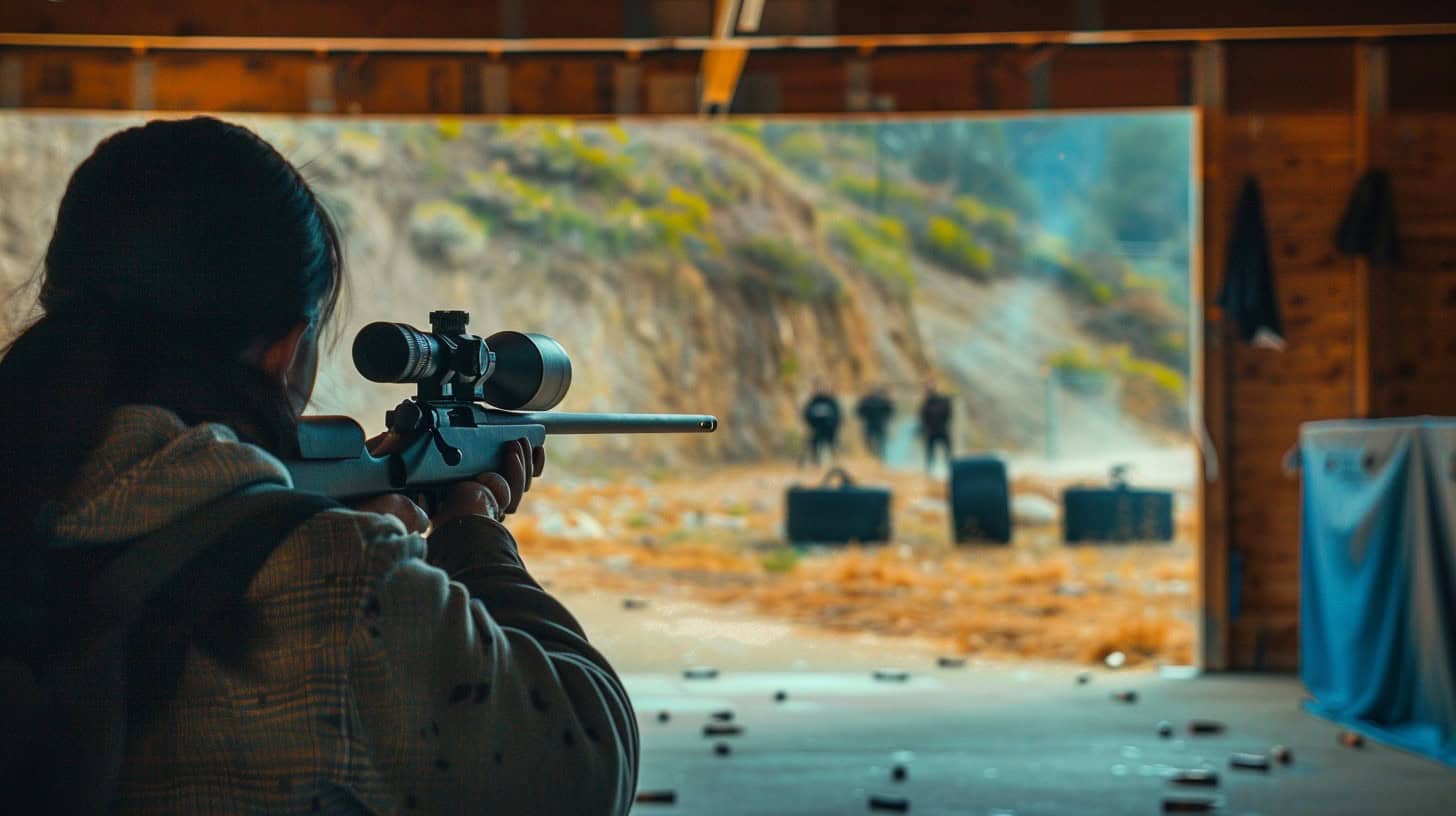Handguns are tricky to shoot well. But mastering the basics can boost your accuracy fast. This guide breaks down 8 key steps to help you become a safe, precise shooter. You’ll learn proper stance, grip techniques, and sight alignment to hit your target consistently. 1
I’ve spent 20 years training new shooters at my local range. I’ve seen the common mistakes beginners make – and how to fix them. We’ll cover everything from choosing the right firearm to advanced skills like managing recoil and using exotic equipment like Starlight night vision scopes.
Get ready to dramatically improve your shooting in just 8 steps. 2
Marksmanship is a precise skill that requires focus, practice, and routine steps for safe and accurate shots. Learning to handle a firearm is essential. 3
Key Takeaways
Proper stance, grip, sight alignment, and trigger control form the foundation for accurate shooting.
The four key rules of gun safety are: treat every gun as loaded, point the muzzle in a safe direction, keep your finger off the trigger until ready to fire, and know your target and what’s beyond it.
Regular dry-fire practice for 15 minutes daily, 6 days a week, helps build muscle memory and improve shooting skills without using ammunition.
Mastering recoil control, speed reloading, and addressing firearm malfunctions are important advanced skills for shooters.
Proper cleaning and maintenance after each use, along with monthly deep cleans, help keep firearms safe and reliable.
Table of Contents
Selecting the Ideal Firearm
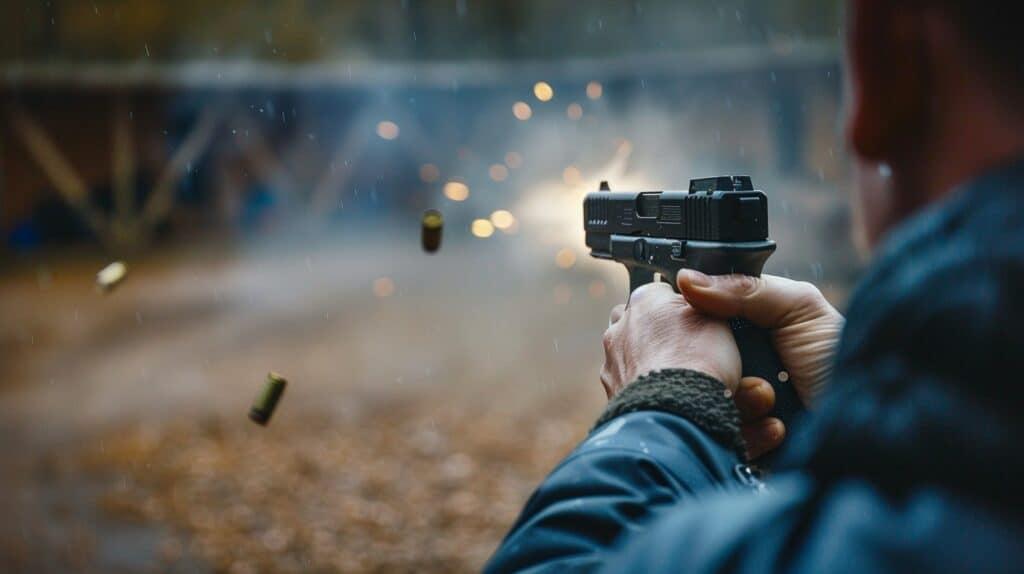
Choosing the right gun matters. Your firearm should fit your hand and purpose.
Exploring Handgun Varieties
Handguns come in two main types: revolvers and semi-automatic pistols. Revolvers feature a rotating cylinder that holds rounds, while semi-automatics use magazines. Each has pros and cons for accuracy, reliability, and ease of use.
Semi-autos typically hold more rounds and reload faster, but revolvers are simpler to operate and less prone to jams. 1
The first rule of gun safety is to treat every firearm as if it were loaded. – Jeff Cooper
Popular handgun brands include Glock, Smith & Wesson, and Sig Sauer. These offer models suitable for target shooting, self-defense, and concealed carry. Factors to consider when choosing include grip size, weight, caliber, and intended use. 2 Start with paper targets at close range (3-7 yards) to build fundamental skills before advancing.
Evaluating Comfort and Fit
Comfort and fit are paramount when selecting a personal defense handgun. A gun that fits well in your hand allows for intuitive use and better control. The contours of the grip should match your palm’s shape, enabling a firm hold without strain.
Your trigger finger should rest naturally on the trigger when gripped properly. 2
Test various models at a range to find your ideal fit. Pay attention to the gun’s weight distribution and how it feels during recoil. A well-fitting firearm will feel like an extension of your arm, improving accuracy and response time. 3 Consider factors like grip texture, slide serrations, and control placement for seamless operation. Your chosen gun should allow for quick, comfortable access to all necessary controls.
Mastering Basic Shooting Techniques
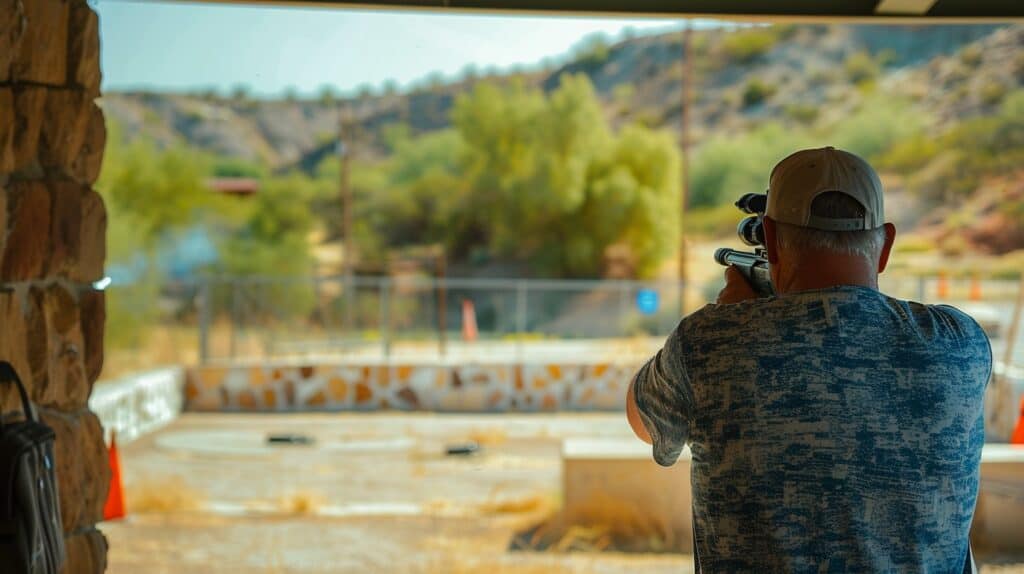
Mastering basic shooting techniques forms the foundation of gun proficiency. Learn proper stance, grip, sight alignment, and trigger control to boost your accuracy and confidence.
Establishing Your Stance and Grip
A solid stance forms the foundation for accurate shooting. Plant your feet shoulder-width apart, with your dominant foot slightly back. Lean forward at the hips, keeping your upper body stable.
Nancy Crenshaw demonstrates this strong posture perfectly. 1
Grip the gun firmly with both hands. Your dominant hand should wrap high on the backstrap, maximizing control. The support hand fills in the gaps, creating a secure hold. A high grip, as shown with the Wilson Custom CQB .45 auto, reduces muzzle flip and improves follow-up shots.
Practice this stance and grip until it becomes second nature. 4
Aligning Sights for Accurate Shooting
Proper sight alignment is crucial for accurate shooting. 4 Mastering this skill takes practice and attention to detail.
- Focus on the front sight. Keep it sharp while allowing the rear sight and target to blur slightly.
- Line up the top of the front sight with the top of the rear sight. Ensure equal light on both sides of the front sight.
- Center the front sight in the rear sight notch. This creates a clear sight picture for consistent aiming.
- Use the sight alignment to place the front sight on the desired point of impact. This technique works for iron sights and red dot optics.
- Maintain a consistent eye position relative to the sights. This helps avoid parallax errors and improves accuracy. 5
- Practice dry firing to perfect your sight picture without recoil interference. This builds muscle memory for proper alignment.
- Experiment with different sight configurations. Some shooters prefer fiber optic or night sights for enhanced visibility.
- Consider adding a red dot sight for faster target acquisition. These can benefit new shooters and experienced marksmen alike.
Practicing Trigger Discipline
Trigger discipline is key to safe, accurate shooting. Keep your finger off the trigger until you’re ready to fire. Rest it on the frame, above the trigger guard. This habit prevents accidental discharges and improves precision.
Focus on a smooth, steady squeeze when firing. Don’t jerk or pull the trigger abruptly. Practice dry firing to perfect your technique without ammo. Use a snap cap to protect your firing pin.
Consistent practice builds muscle memory for better control and accuracy. 6
Gun enthusiasts know trigger control makes or breaks a shot. Maintain a firm, even pressure throughout the pull. Don’t anticipate recoil or flinch. Let the shot surprise you. This approach minimizes movement and enhances precision.
Master trigger discipline through regular range sessions and dry fire practice. It’s a fundamental skill for both self-protection and competitive shooting. 5
Implementing Gun Safety Protocols
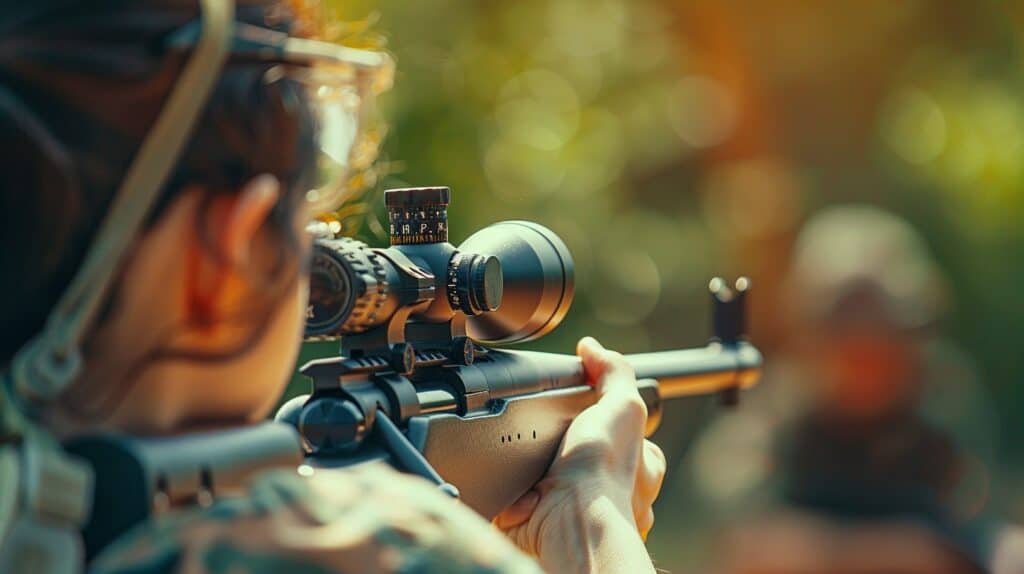
Gun safety is crucial for every shooter. Learn the basics to protect yourself and others.
Adhering to the Four Rules of Gun Safety
Gun safety rules form the foundation of responsible firearm handling. These four key principles ensure a safer environment for everyone involved.
- Treat every gun as loaded: Always assume a firearm is ready to fire, even if you’re sure it’s empty. This mindset prevents accidents caused by false assumptions. 7
- Point the muzzle in a safe direction: Keep the gun aimed away from people, animals, or anything you don’t intend to shoot. A safe direction is typically downrange or at the ground. 8
- Finger off the trigger: Rest your trigger finger along the frame until you’re ready to fire. This prevents accidental discharge if you’re startled or lose balance.
- Know your target and beyond: Identify your target clearly and what’s behind it. Bullets can travel through objects, so be aware of potential ricochets or over-penetration.
Using Protective Gear Effectively
Proper protective gear is crucial for safe shooting. Always use both in-ear plugs and over-the-ear shooting earmuffs to double up on ear protection. Electronic muffs offer an advantage by magnifying ambient sounds while blocking high-decibel noises.
Quality eye protection shields against ricochets and ejected casings.
Safety isn’t expensive, it’s priceless.
For optimal safety, invest in a comfortable pair of shooting glasses with shatterproof lenses. Choose ear protection rated for the specific decibel level of your firearm. 61% of U.S. gun owners have received formal safety training – joining their ranks enhances your protective knowledge and skills. 9
Developing Effective Practice Routines
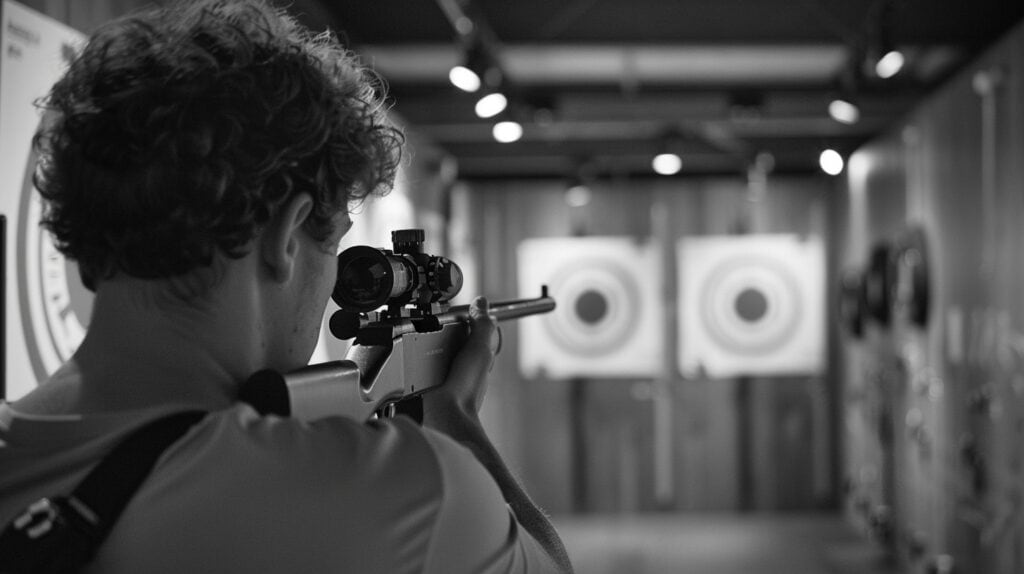
Mastering gun skills takes practice. Regular dry-fire sessions and range time will sharpen your aim and boost your confidence.
Engaging in Dry Fire Sessions
Dry-fire practice sharpens shooting skills without ammo costs. This method involves simulating firearm operation with an unloaded gun. Experts recommend 15-minute daily sessions, six days a week. 11 The program covers fundamental shooting and handling techniques. It’s designed for all skill levels, from novices to pros.
Specific drills come with par times and rep counts. These help shooters track progress and push limits. 12 Key focus areas include trigger control, sight alignment, and proper grip.
Regular dry-fire training builds muscle memory and confidence. It’s a safe, effective way to maintain proficiency between range visits.
Utilizing Reactive Targets
Reactive targets offer instant feedback, making them ideal for new shooters. Steel plates, spinning targets, and self-sealing polymer designs provide visual and auditory cues upon impact.
These targets enhance accuracy and boost confidence by showing immediate results. Choose targets that fragment or fall when hit to avoid ricochet risks. Opt for high-quality, durable materials designed specifically for firearms training. 14
Proper placement of reactive targets is crucial for safety and effectiveness. Set them at appropriate distances based on your skill level and firearm type. Use a variety of target sizes and shapes to challenge yourself and improve precision.
Incorporate movement patterns or timed elements to simulate real-world scenarios. Always follow range rules and wear proper protective gear when using reactive targets. 13
Executing Shooting Drills
Shooting drills hone your skills and build muscle memory. Here are key drills to master:
- Dry Fire Practice: Aim at a target without ammo. Focus on trigger control and sight alignment. 15
- Ball and Dummy Drill: Mix live rounds with snap caps. Helps identify and fix flinching.
- Mozambique Drill: Fire two shots to the chest, one to the head. Improves speed and accuracy.
- Failure Drill: Practice clearing jams and malfunctions quickly. 16
- El Presidente: Engage multiple targets while moving. Enhances situational awareness.
- Dot Torture Drill: Shoot 50 rounds at small targets. Tests precision and consistency.
- Bill Drill: Fire six shots at a single target as fast as possible. Builds speed and control.
- Reload Drills: Practice speed reloads and tactical reloads. Crucial for real-world scenarios.
Next, we’ll explore choosing a suitable shooting range for your practice sessions.
Enhancing Advanced Shooting Skills
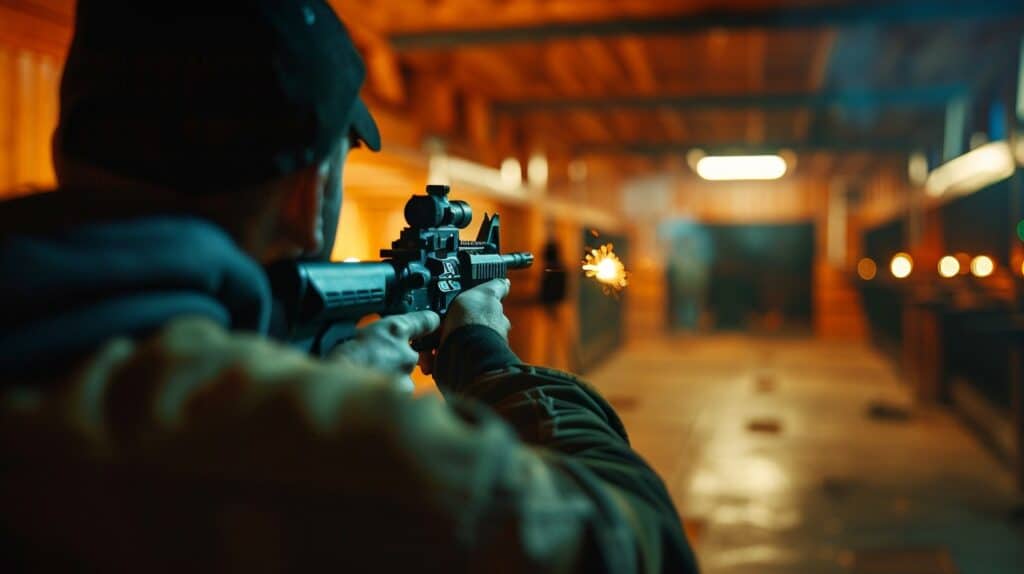
Ready to level up? Master recoil control, quick reloads, and malfunction fixes… plus learn to use night vision gear. Keep reading to sharpen your skills!
Managing Firearm Recoil
Mastering recoil control is crucial for accurate shooting. Grip the firearm firmly, with your dominant hand high on the backstrap and your support hand covering the remaining grip space.
Lean slightly forward, keeping your arms extended but not locked. This stance absorbs shock and minimizes muzzle rise. 18
Practice with a .22 rifle to grasp recoil management basics. Proper shoulder placement prevents upward point-of-aim shifts after firing. Maintain consistent pressure on the stock for a stable sight picture.
Regular dry-fire drills improve trigger control and muscle memory, enhancing overall recoil management skills. 17
Mastering Speed Reloading
Speed reloading is crucial for winning gunfights. Drop the empty magazine and swiftly insert a fresh one from your belt. 19 Practice this skill as often as shooting drills. Efficient reloads can make the difference between life and death in high-stress situations.
Proper technique involves muscle memory and smooth motions. Grip the new magazine firmly, align it correctly, and seat it with authority. Train to execute flawlessly under pressure. 15 Regular practice at the range builds confidence and speed for real-world scenarios.
Addressing Firearm Malfunctions
Mastering speed reloading sets the stage for handling unexpected issues. Addressing firearm malfunctions quickly and safely is crucial for any shooter.
- Clear jams immediately: Remove the magazine, rack the slide, and visually inspect the chamber. 9
- Identify common malfunctions: Recognize failures to feed, fire, or eject.
- Practice malfunction drills: Simulate various issues during dry fire sessions.
- Use proper ammunition: Select the correct caliber and quality rounds to prevent issues.
- Keep your firearm clean: Regular maintenance reduces the risk of malfunctions.
- Learn tap-rack-bang technique: Address minor stoppages swiftly with this method.
- Understand double-feeds: Clear complex malfunctions by removing the magazine and cycling the action.
- Seek professional training: Courses cover malfunction clearing and safe handling procedures. 15
Utilizing Night Vision Scopes
Starlight night vision scopes revolutionize low-light shooting. These optical devices amplify existing light, enabling clear target identification in near-total darkness. Shooters gain a significant edge, improving accuracy and safety during nighttime operations. 20 Night vision technology enhances situational awareness, crucial for both tactical and recreational purposes.
Proper use of night vision scopes requires practice and understanding of their limitations. Factors like ambient light levels and weather conditions affect performance. Users must calibrate their scopes correctly and maintain them meticulously for optimal results.
Integrating night vision into regular training routines ensures proficiency and maximizes its benefits in real-world scenarios. 21
Choosing a Suitable Shooting Range

Picking the right shooting range is key for safe practice. Look for ranges with clear safety rules, good lighting, and proper ventilation to ensure a comfortable experience.
Identifying Key Features of a Quality Range
A quality shooting range is essential for honing your skills. Look for these key features to enhance your shooting hobby:
- Safety protocols: Strict adherence to firearm safety rules, including eye and ear protection requirements. 22
- Qualified staff: Certified range officers and instructors on-site.
- Well-maintained facilities: Clean, organized, and regularly inspected equipment and target systems.
- Variety of targets: Options for static and reactive targets to practice different scenarios.
- Adequate lighting: Proper illumination for clear sight picture and target acquisition.
- Ventilation system: Efficient air filtration to remove lead particles and gunpowder residue. 23
- Sound dampening: Measures to reduce noise levels and prevent hearing damage.
- Range of distances: Multiple shooting lanes with varying distances for diverse practice.
- Rental options: Availability of firearms and gear for trying different models.
- Training programs: Offered courses for beginners and advanced shooters to improve skills.
Now, let’s explore the importance of following range etiquette to ensure a safe and enjoyable experience for all shooters.
Following Range Etiquette
Range etiquette is crucial for safety and respect. Always point your muzzle downrange – it’s non-negotiable. 24 Learn key terms: firing line, hot/cold range, backstop, and lanes.
These basics prevent accidents and earn you respect from fellow shooters. Keep noise to a minimum, clean up after yourself, and follow all range officer instructions without question.
Safety gear is mandatory. Wear ear protection and eye guards at all times. Don’t touch firearms during ceasefire periods. Stay behind the firing line unless instructed otherwise. Be aware of your surroundings and other shooters.
Proper etiquette keeps everyone safe and enhances the shooting experience for all. 25
Caring for Your Firearm
Proper gun care keeps your firearm safe and reliable. Regular cleaning and maintenance extend its life and performance.
Conducting Regular Cleaning and Maintenance
Regular cleaning and maintenance are essential for gun safety and performance. Here’s a guide to keep your firearm in top shape:
- Clean after every use: Wipe down the exterior with a soft cloth. Remove residue from the bore using a cleaning rod and solvent. 27
- Deep clean monthly: Disassemble the firearm. Scrub all parts with a brush and gun-specific cleaner.
- Inspect components: Check for wear on springs, firing pin, and extractor. Replace parts showing signs of damage.
- Lubricate moving parts: Apply a thin layer of gun oil to slide rails, barrel, and other friction points.
- Store properly: Keep in a cool, dry place. Use a gun safe or locked cabinet to prevent unauthorized access. 26
- Check sights and optics: Ensure red dot sights or telescopic sights are properly aligned and securely attached.
- Test fire regularly: Visit a shooting range to verify function and accuracy after maintenance.
- Follow manufacturer guidelines: Consult your owner’s manual for specific care instructions for your firearm model.
Proper care extends the life of your gun and ensures reliable performance. Next, we’ll explore the importance of understanding your firearm’s owner’s manual.
Comprehending the Owner’s Manual
Firearm owner’s manuals contain crucial info on safe operation, maintenance, and troubleshooting. Read yours cover-to-cover. Pay attention to specific safety features, disassembly steps, and cleaning instructions for your model. 29 Many manuals include diagrams of internal components – study these to understand your gun’s mechanics. Knowing your firearm inside and out enhances safety and performance.
Manuals often list recommended ammo types and warn against unsafe modifications. 28 They detail proper storage methods to prevent unauthorized access. Some include targets for sighting in your weapon.
Keep your manual accessible for quick reference. If you lose it, most manufacturers offer digital versions online. Thorough manual knowledge is key for responsible gun ownership.
People also Ask
What’s the first step in learning to shoot a gun safely?
Start with firearms safety. Learn the manual safety, grip safety, and proper handling. Always treat guns as loaded.
How do I choose the right gun for my handedness?
Consider your dominant hand. Right-handed? Go for right-handed models. Left-handed? Seek left-handed options. Some guns work for both.
What’s the difference between single action and double action?
Single action needs manual cocking. Double action cocks and fires with one trigger pull. Double action revolvers offer both options.
How important is proper breathing when shooting?
Crucial. Control your breath. Exhale halfway, then hold before pulling the trigger. This steadies your aim for better accuracy.
What types of sights are available for guns?
Options include rear sights, front sights, red-dot optics, and optical sights. Some prefer traditional iron sights, others like modern alternatives.
Where can I practice shooting safely?
Visit shooting ranges. They offer controlled environments for practice. Some have bench rests for stability. Always follow range rules.
References
- ^ https://www.backwoodshome.com/how-to-shoot-a-handgun-accurately/
- ^ https://www.personaldefensenetwork.com/post/defensive-firearms-priorities-how-to-choose-a-personal-defense-handgun (2010-03-23)
- ^ https://www.therange702.com/blog/7-fundamentals-marksmanship/ (2022-02-22)
- ^ https://www.police1.com/police-products/firearms/training/articles/8-fundamentals-that-can-make-you-a-better-shooter-Sc7S4FAfFV391b3X/
- ^ https://www.hunter-ed.com/muzzleloader/studyGuide/Rifle-Firing-Techniques-Practicing-the-Five-Fundamentals/222099_88875/
- ^ https://tacticalhyve.com/ultimate-guide-to-trigger-discipline-and-trigger-control/
- ^ https://www.hunter-ed.com/national/studyGuide/The-Four-Primary-Rules-of-Firearm-Safety/201099_93163/
- ^ https://www.hunter-ed.com/national/studyGuide/Introduction-to-Firearm-Safety/201099_92994/
- ^ https://www.rand.org/research/gun-policy/analysis/firearm-safety-training-requirements.html (2020-04-22)
- ^ https://efsgv.org/learn/learn-more-about-gun-violence/public-health-approach-to-gun-violence-prevention/
- ^ https://forums.brianenos.com/topic/96029-ben-stoegers-15-minute-dry-fire-program/ (2009-11-19)
- ^ https://www.everydaymarksman.co/marksmanship/dry-fire/ (2020-01-28)
- ^ https://www.ncbi.nlm.nih.gov/pmc/articles/PMC7866873/
- ^ https://www.handgunsmag.com/editorial/training-with-action-targets/137847
- ^ https://thecmp.org/wp-content/uploads/2021/01/TRAINING-%E2%80%93-Part-I-The-Way-to-Success-in-Shooting.pdf
- ^ https://www.ncbi.nlm.nih.gov/pmc/articles/PMC7495246/
- ^ https://www.snipershide.com/shooting/threads/how-do-you-manage-recoil.222824/
- ^ https://www.thearmorylife.com/practical-skills-recoil-management-for-speed-and-accuracy/ (2021-01-30)
- ^ https://www.ojp.gov/ncjrs/virtual-library/abstracts/firearms-tactics-mastering-magazine
- ^ https://apps.dtic.mil/sti/tr/pdf/ADA297284.pdf
- ^ https://www.chrissajnog.com/blog/how-to-shoot-with-both-eyes-open/
- ^ https://thegallerysportsmansclub.com/8-essential-shooting-range-tips/ (2024-02-27)
- ^ https://www.hunter-ed.com/national/studyGuide/Know-Your-Firearm-s-Range/201099_92857/
- ^ https://keystoneshootingcenter.com/blog/how-to-practice-proper-gun-range-etiquette
- ^ https://www.hunter-ed.com/national/studyGuide/Firearm-Safety-at-the-Shooting-Range/201099_92998/
- ^ https://www.actiontarget.com/firearm-maintenance-essentials/ (2023-09-29)
- ^ https://www.hunter-ed.com/pennsylvania/studyGuide/Steps-for-Cleaning-a-Firearm/20103901_88461/
- ^ https://www.nssf.org/safety/rules-firearms-safety/
- ^ https://www.hunter-ed.com/national/studyGuide/Steps-for-Cleaning-a-Firearm/201099_92865/
